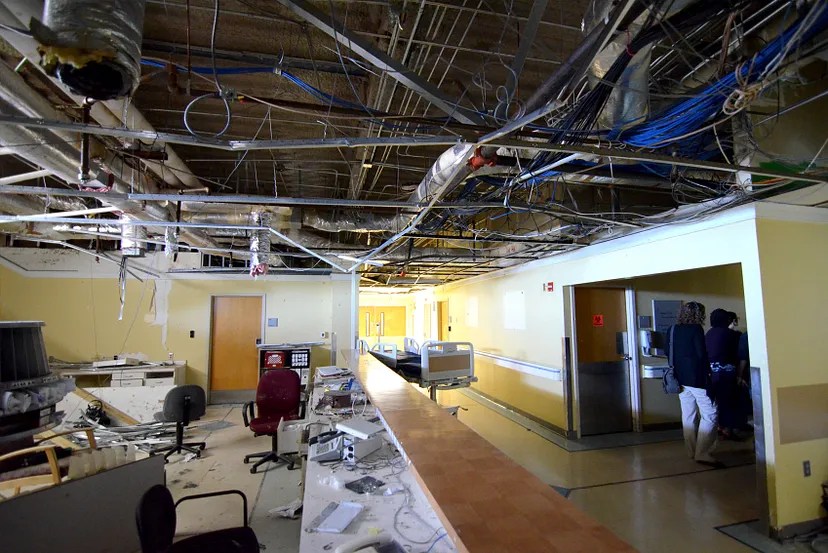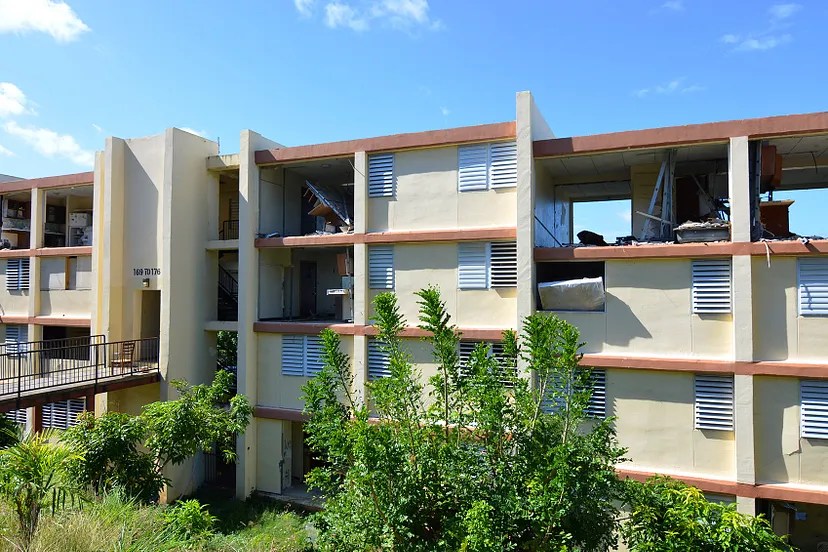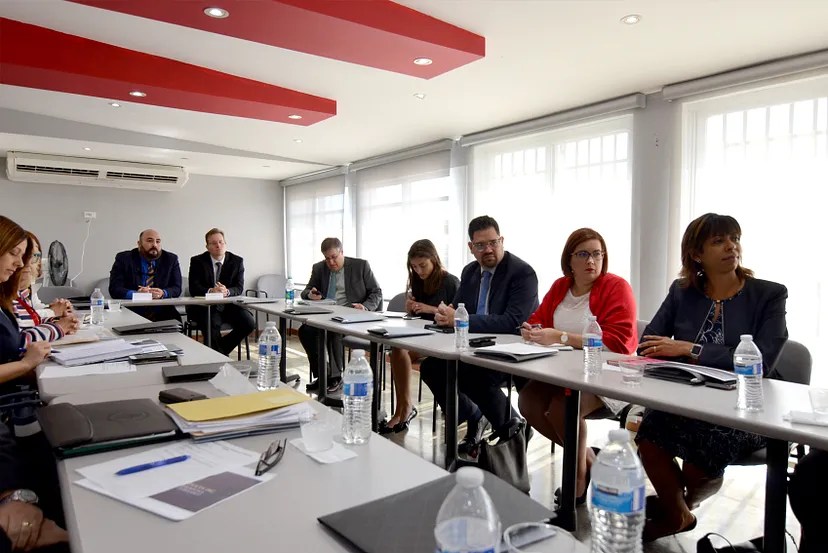
In the first regional roadshow of 2018, President Dudley and a team from the New York Fed traveled to San Juan, Puerto Rico and St. Thomas in the U.S. Virgin Islands (USVI) to meet with local nonprofit, government, and business leaders, with the aim of understanding economic conditions and recovery efforts in the aftermath of Hurricanes Irma and Maria. The devastation of these storms resulted in a significant setback to areas already facing very difficult circumstances.
While statistics, images, and news reports all provide important insight, a first-hand view of the economic and humanitarian situation is invaluable to appreciating what might lie ahead for these islands on the road to recovery.
In this two-part series, we will share key takeaways from our visit. Today’s post focuses on the critical areas of the economy that were impacted by the storms. Tomorrow’s post turns to the islands’ future economic paths.
Storms Exacerbated Existing Issues
The economies of both Puerto Rico and the USVI had been weak for many years before the hurricanes exacerbated existing conditions. One of the most visible areas of concern before the storms was power and telecommunications infrastructure. High electricity prices and frequent outages were not uncommon before Maria and Irma, and the Puerto Rico Electric Power Authority struggled with high levels of debt and an outdated energy grid. An estimated 50% of Puerto Rico was without power for at least three months after the storms, while roughly 5% remains without power today. And even in many areas where power has been restored, there have been subsequent outages. In the USVI, we also heard complaints about electricity service both before and after the storms, though the restoration did not appear to have been as problematic as on Puerto Rico, which is much larger and more populous.
During our meetings in Puerto Rico and the USVI, local business and community leaders repeatedly cited the unreliability of power and broadband, along with water and sewage service disruptions, as major impediments to recovery. Generators are very expensive to purchase and operate, and they are not designed to run for months on end. Still, many residents continue to rely on generators since they have no alternative. Residents must limit their power usage to just a few hours each day and generally for only essential appliances. Business leaders emphasized that the lack of reliable power continues to interrupt operations for local companies and for people who work remotely from the islands — causing closures of businesses in some industries and spurring others to move away.
The storms also caused steep job losses. While the employment picture in Puerto Rico has improved somewhat in recent months, the recovery in the USVI is lagging. Tourism is a critical industry in the USVI, yet many hotels — which are major employers for the islands — have closed and do not plan to reopen until 2019 at the earliest.
Together, these issues contribute to another persistent concern: out-migration. The populations of both Puerto Rico and the USVI have been declining for over a decade, and the outflow of residents has increased since the storms. The New York Fed’s analysis of domestic air passenger data suggests that from September through December nearly 200,000 people left Puerto Rico, net of arrivals. However, many of these departures were likely visitors who left but were not replaced by a new, incoming cohort of visitors after the storm. By January, however, the exodus began to reverse, as Puerto Rico saw net arrivals of roughly 63,000 people.

Labor leaders in San Juan explained that skilled workers are leaving because of limited resources and job opportunities. We also learned that the USVI has an aging population as many young people move to the U.S. mainland to pursue higher education and do not return. Meeting participants expressed concern that this outflow might continue because of the state of the educational system. Due to structural damages from the storms that rendered many school buildings unusable, many students are attending only half-days of classes so that schools can accommodate all of their students. Further, as a result of the two hurricanes, approximately 325 of the University of the Virgin Islands’ 2,400 students withdrew from the current school year. In Puerto Rico, the Department of Education recently announced the closure of 283 schools for the upcoming school year after projecting a decline of 38,000 students.
Likewise, Roy Lester Schneider Hospital on St. Thomas lost over 170 employees — including more than 40 nurses — and there is uncertainty about how many will return. The loss of medical experts is straining the islands’ already-limited mental health resources at a time when residents most need support.
Housing Challenges
A key metric of recovery from natural disasters is how quickly residents can return to secure, stable housing. We learned from stakeholders in the USVI that, even before the hurricanes, the region suffered from a lack of affordable housing due to limited land and steep development costs. Irma and Maria damaged a wide swath of the housing stock, and about half of all hotel rooms were impaired. With limited hotel rooms available, relief agencies turned to the rental market to house the workers who have descended in droves as part of the recovery effort — contributing further to the acute housing shortage. As a result, local social service agencies are now struggling to secure affordable transitional rental units. Business leaders even attempted to secure a cruise ship to alleviate the housing shortage, but upfront costs and guarantees were a barrier.

In Puerto Rico, housing counselors explained that many homeowners, especially those in rural communities, do not have property titles and have relied on informal construction to develop their homes. Since they didn’t have insurance or formal claim to their land beforehand, it has been very difficult for them to get assistance from FEMA. Counselors explained that this issue is disproportionately impacting the poor and may have ramifications on how Puerto Rico’s housing stock is rehabilitated.
Housing counselors also expressed concern about the upcoming expiration of mortgage payment moratoriums. The moratoriums issued for various government-insured loans provided much-needed relief to homeowners facing job losses and basic food and medical expenses following the storms. However, there are several different types of mortgages — including mortgages insured by the Federal Housing Administration, Veterans Affairs, the U.S. Department of Agriculture Rural Development, Fannie Mae, and more — each with different terms and moratorium expiration dates.
Mortgage financing is complex by nature, with different types of mortgage loans and terms that are dependent on lender and insurer guidelines. Following a disaster, these complexities are only further exacerbated. Counselors are reporting confusion among homeowners about the terms of the moratoriums, which vary significantly based on the type of mortgage. Government guaranteed loans tend to have the most transparent terms, whereas other loans are reported to be handled on a case-by-case basis. Many homeowners are said to be uncertain about how mortgage payments will work once the moratorium ends, and whether they will be expected to catch up on several months’ worth of missed payments directly after the moratorium ends.
The full impact of the hurricanes on the housing sector is not yet apparent. It is not clear how many people abandoned their homes, and statistics are not yet available on the number of homeowners becoming delinquent after payment moratoriums expire. Given the extensive damage across the Island and an economy that has been declining for over a decade, foreclosure prevention counselors expressed apprehension that a growing number of homeowners may owe more on their mortgages than their houses are worth after suffering damage — which could put them at risk of foreclosure.
Experts from the Legal Services of Puerto Rico (LSPR) said that, even before Maria, Puerto Rico’s high foreclosure rate was of concern. According to data received by LSPR from the Island’s Oficina de Administracion de Tribunales, the local court system, 66,085 mortgage foreclosures were filed from 2013 to 2017.

Ricardo Ramos-Gonzalez, who runs the Foreclosure Prevention Legal Aid Clinic at the University of Puerto Rico Law School, estimates that since 2010 at least 55,000 mortgage loans have been sold to private investors — at which point reporting to the Puerto Rico Office of Commissioner of Financial Institutions isn’t mandatory. This makes those loans much harder to track and makes it much more difficult to understand the scope of the problem in order to effectively allocate resources.
We heard very different perspectives in our conversations with representatives from banks and advocacy groups. Housing advocates claim that banks are reluctant to write down the value of a loan and instead foreclose, often selling properties at lower amounts than would have been gained through loss mitigation. Community advocates are concerned that foreclosed properties will quickly fall into disrepair or be vandalized. They are calling for a local version of the U.S. Treasury’s Home Affordable Mortgage Program — which would allow for loan modifications in the event of increased expenses, reduced incomes, or an unpaid principal balance reduction that will provide “clear and consistent loan modification guidelines that the entire mortgage industry should use.” Meanwhile, bank representatives do not seem to think the situation is that dire and are concerned that additional local regulations will constrain investment capital during a time of rebuilding and may also scare off foreign and mainland investors.
Given the conflicting accounts and many unknowns, the New York Fed is actively working to provide support where possible. In late March, the New York Fed co-hosted a Disaster Recovery Resource Fair in Humacao, Puerto Rico, which provided information and guidance for homeowners. Our Research & Statistics team is also closely examining the Island’s housing situation in an effort to provide insight and clarity on these issues.
Hurricanes Irma and Maria exposed and placed additional strain on issues that had been developing for many years before the storms. Check back tomorrow for Part II of this series, in which we will look at shifts underway on the islands and future economic possibilities.
This article was originally published by the New York Fed on Medium.
The views expressed in this article are those of the contributing authors and do not necessarily reflect the position of the New York Fed or the Federal Reserve System.










